This question comes up all the time and it needs to be answered. My apologies to the reader who might perceive this piece more as an advertisement than an article.
Russian coach, Andrey Kozhurkin, made a 50,000-foot observation on the two diametrically opposed philosophies of stimulating adaptation.
The traditional one is pushing to the limit: “What does not kill me, makes me stronger.”
The alternative is to train to “avoid (or at least delay) the unfavorable internal conditions…that lead to failure,” or reduced performance.

Let us use strength training as an example. The majority of bodybuilders and recreational athletes use the first approach. They train to failure.
In contrast, strength athletes such as Olympic weightlifters and powerlifters follow the second approach. 1,000-pound squatter, Dr. Fred Hatfield, famously proclaimed that one ought to “train to success,” as opposed to failure. The differences between the American and Russian powerlifting methodologies notwithstanding, both countries’ strength elites share the same conviction that failure is not an option.
In endurance training, the first philosophy represents the consensus. Coaches expose athletes to acid baths to improve buffering. This is what Arthur Jones from Nautilus called “metabolic conditioning” back in 1975.
We shall go the other way: anti-glycolytic training (AGT).
Anti-Glycolitic Training
The creator of AGT, Prof. Yuri Verkhoshansky, summed it up back in the 1980s (his emphasis):
“The central methodological idea of movement endurance training can be expressed briefly: increasing muscles’ aerobic power as a condition for effective utilization of lipid metabolism. To be even more laconic, training must have an “anti-glycolytic” direction, that is lower glycolysis involvement to an absolute possible minimum.”
This revolutionary methodology has delivered performance breakthroughs on a number of Russian national teams in a mind-numbingly diverse array of sports: judo, cross country skiing, rowing, bicycle racing, full-contact karate…
Broadly, there are three categories of AGT methods: Classic AGT, Slow Twitch Muscle Fiber Hypertrophy, and Q&D.
Classic AGT (Verkhoshansky)
It maximizes the aerobic metabolism in fast twitch fibers while minimizing glycolysis.
The good professor explained: “The exercises are organized in a way which allows the loading of the CP mechanism during each set and the stimulation of the aerobic mechanism for its recovery between sets and series.” Thus, the training is predominantly alactic and aerobic. “A+A,” as Al Ciampa, SFG has snappily compressed it.
One of Verkhoshansky’s original protocols involved ~8sec sprints separated by enough rest to stay below the anaerobic threshold, but it only scratches the surface of AGT. The science of biochemistry with its insights into the timing and interaction of various metabolic events has enabled the professor himself and those who followed him to develop a great variety of sophisticated anti-glycolytic methods and tactics.
Some templates aim at explosive repeat effort sports like rugby and others at less intense but more prolonged events like OCR.
Some maximize high speed or power endurance while others build endurance in “grinds” for wrestling, high rep pull-ups, etc.
Slow Twitch Muscle Fiber Hypertrophy Method (Selouyanov)
It works because type I fibers come densely preinstalled with mitochondria: building the former nets more of the latter.
In addition to developing this original method, Prof. Victor Selouyanov was a tireless advocate of Verkhoshansky’s AGT and made many contributions to it.
Q&D Protocol (StrongFirst)
It optimizes the metabolic conditions for upregulating the master regulator of mitochondrial growth, PGC-1α. It was designed to do what many HIIT protocols tried—but better and without collateral damage to the body.
Q&D and A+A (e.g., in its simplest form, 5 high power swings or snatches OTM, or on the minute) are highly complementary. Q&D builds more and bigger mitochondria and A+A makes them function better. (The technical terms are “mitochondrial biogenesis” and “mitochondrial respiration,” respectively.)
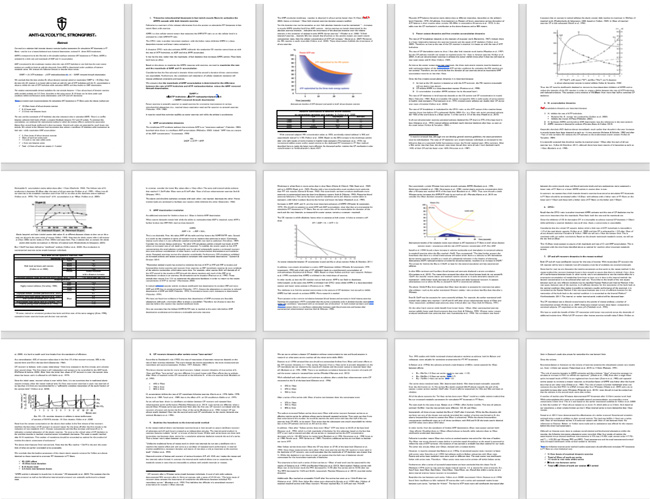
Enter Strong Endurance™
Strong Endurance is an umbrella term for a wealth of anti-glycolytic training methods listed above.
Plus select glycolytic methods, chosen for their effectiveness and a minimum of side effects. A precise dose of acid taken several times before a competition in a sport that makes the legs and the lungs burn is a must to make the athlete reach peak performance. This is called “glycolytic peaking.” It also comes bearing a whole package of WTHE (“what the heck effects”).
In summary, The Quick and the Dead protocol is one of the eighteen AGT training templates presented at the Strong Endurance™ seminar:
Templates #1-7: Fast and Intermediate Fibers’ Aerobic Training
Make your fast fibers aerobic—without sacrificing power and strength—for games and combat sports.
Templates #8-11: Intermediate Fibers’ Aerobic Training
For military, law enforcement, first responders.
Templates #12-13: Intermediate and Slow Fibers’ Aerobic Training
March or die. Lose fat.
Templates #14-16: Fast and Intermediate Fibers’ Hypertrophy
Build more muscle—while improving your acid buffering.
Templates #17-18: Slow Fibers’ Hypertrophy
A game-changer for wrestling and for training around injuries.
To give you an idea of what else you will learn, here is the table of contents of the dense, heavily referenced Strong Endurance™ seminar manual:
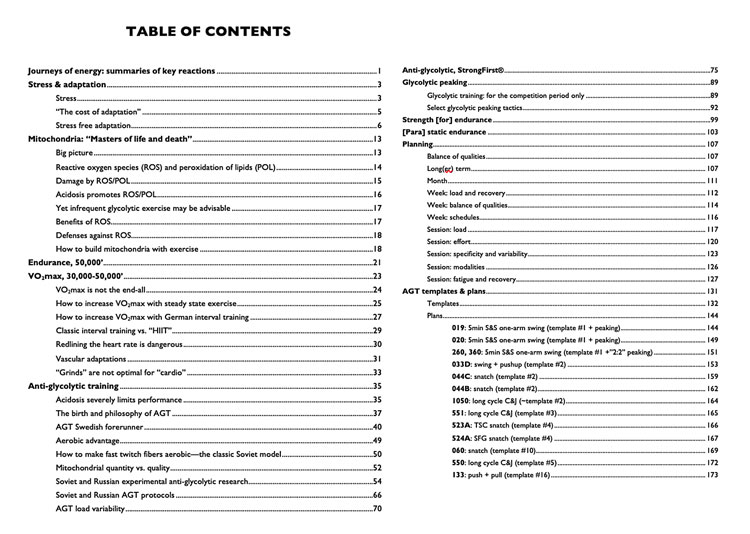
The seminar is taught both in plain English and in biochemistry terms.
I will wrap up with a quote from Prof. Verkhoshansky:
Endurance traditionally has been associated with the necessity to fight fatigue and with increasing the athlete’s organism’s tolerance to unfavorable changes in the internal environment. It was thought that endurance is developed only when athletes reached the desired degrees of fatigue…Such views linked endurance to a fatalistically inevitable decrease in work capacity…and lead to a passive attitude towards endurance development…“tolerate” and put up with the unavoidable unpleasant sensations rather than actively search for training means that reduce fatigue, postpone it, and make it less severe…
[Yet] the goal is not taking the athlete to exhaustion to accustom him to metabolic acidosis, as it is often understood in athletic practice, but just the opposite…to develop alactic power and to increase the muscles’ oxidative qualities…
So another training principle was proposed to improve endurance: improving the capacity in avoiding the factors which provoke fatigue instead of improving the capacity in tolerating it. This training principle was named “anti-glycolytic”…
Related Resources
Learn more about Strong Endurance™
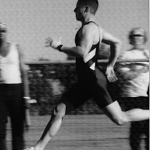
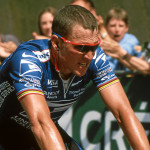

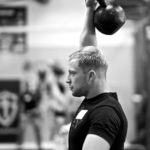

Firstly, thanks so much for the time and effort that has clearly been invested in all of your work. I have started the Q and D and feel great. You mention that Q and D can be alternated with A+A in blocks of training – I wondered whether individual sessions from these protocols could be interspersed together, (i.e. doing 2 x Q+D and 2 x A+A in a week) or whether this some how negatively impacts the benefits of either.
Hello,
Regarding the current COVID situation i doubt any seminar will take place for a quite a while, is there any chance to purchase the strong endurance seminar manual?
Love your work with strong first, as a BJJ competitor and fitness coach I was always struggling to program my own camp training before competition to avoid lactic damage and soreness on BJJ practice from strength & conditioning training … since I found your work and Prof. SELUYANOV studies regarding slow fiber type & mitochondria training for wrestling/grappling it’s a game changer for my training.
Thank you !
In the previous slow twitch articles you said a person should only do that type of training if they’re going to commit to it long term, as they’d lose their gains otherwise. But suppose someone did a cycle of full-body, slow twitch training. Could that leave subtle changes in structure and biochemistry, providing minor but long-lasting benefits, even if that type of training was never repeated?
Very interesting and it ties in with my own experience at 55 years of age. I need to be able to get up in the morning and walk downstairs without DOMS etc.
However as former 48 second 400m runner the necessity for lactate training was key in the build up to an event…however not too much.If I had a race on a Saturday then on Wednesday I would run 2x 300m and then 2x150m sprints but with 8-10 minutes between each and every rep. Relaxed fluid speed was the key.
3 decades on though I am in it for the health and fitness not the competitive angle.Therefore the my focus is on quality of movement and life- the 2 are not always compatible with elite performance! However you make you choice and pay the price.
Good afternoon, sir.
We have a national problem here in Brazil. Or rather, a big soccer problem.
I’m a big fan of A+A, but in high income soccer, with its billions in spending, what happens?
Apart from the technical and cultural aspects, it’s almost a consensus around here that the teams, or national teams, from the eastern countries have very strong players, but they can’t take the second half.
We lost the ’88 Olympics to you, but around here it’s a consensus that the strength factor was paramount. That’s a point for you.
But more and more, especially after the 1990s, the gap has widened. In the last World Cup final, in the second half, France was flying… Croatia… Sad.
Everything has a price, of course. In the 80s, a player in Brazil ran an average of 4 to 7 km, today it’s 7 to 11 and it’s not difficult to find players who run 14 to 16. A big team in Brazil, makes on average 74 more games a year… Multiplied by 90 minutes.
Football: you walk a little, you run a lot and some good sprints, short and long. Plus the lateral and backward movements. Very good for ankles and knees. But we love it. And even with that volume, even in the richest teams, the preparation is almost always in the “no pain, no gain” style. And sir, it works… At least for a while.
Example: the robot monster Cristiano Ronaldo. 2016 a new physical trainer arrives at Real Madrid. I will omit the name. He coaches Cristiano, and much of the team, like Luka Modric, in a painless, winless style: Cristiano was the best player in the world in 2017 and Modric in 2018. Two monsters. But… In 2019 they both suffered a lot from injuries and low yields. Sad to see… At the end of the games, you could see them extremely tired. They’re both over 30. Modric was not even in the top 30 players of 2019… …for who was the best in 2018… Again, sad.
Sir, I still think that at world level, in soccer, most great teams have a strength training that borders on the joke. I won’t even comment on Brazil. Strongfirst was definitely never our motto. We’re changing. Some good men have worked hard at it.
José Roberto Guimarães: three-time Olympic coach woman volleyball champion. After taking a beating from the Russian national team at the 2004 Olympics, he realized how much the strength of the Russian players made the difference. He demanded that this foundation be corrected. He changed the whole strength training methodology. History: We won two other Olympics with our girls after that.
So, basically, I have a few simple questions for you:
Is it possible to reach the level of intensity of the big clubs in the West (what Liverpool and Manchester City are on the verge of absurdity!) with specific A+A training?
Is it possible to reach Cristiano Ronaldo’s level in 2017 and 2018 and keep him without injuries or prolonged fatigue that has lasted more than a year?
Sir, I’m sorry, but we flew on the field (at least for 3 months in the season, then come the injuries, change of players, chronic fatigue …) But at the peak of each one, you eat worse with us! Of course, if you catch us, you kill us in strength… But that’s another problem!
I know that no high performance sport is healthy, but I think it’s sad to see such technically good players no longer able to play in great shape when they’re only 32, 33… It’s sad. They fly for 5, 6 years and they did. Cruel.
Or would the problem be that in eastern football, unlike other sports, there is no culture of A+A training?
Or is football the problem? With its excess of games and time during the season?
Is it possible for a world-class player to play as if he were training in “no pain, no gain”, but training A+A and thereby increasing his time in the game?
Simple questions for you, no? Who knows a book about football training? Just a Brazilian dream?
Sir, excuse the size and my English.
Thank you very much. You changed my life.
I have some simple methods of training that could help. Pavel has mentioned in the past your strength program doesn’t have to be specific to your sport, a “general preparedness” strength program with sport specific practice can make a huge difference.
In a nutshell, make the body strong and then hone it to it’s sport.
You can’t replicate the dynamic movements of a sport with a weight lifting program, adding weight to those type of movements will set you up for injuries galore.
Make the muscles strong, teach them to finction as a unit, then simply play the sport. Build strength in the movement of gameplay.
I have more details in old training notes but that is the oversimplified theme that has worked very well over the years. I can’t speak much on the specific needs of soccer players (my experience is combat sports) but I did design drills for fighters using the sport of soccer as a medium. Jose Aldo inspired them (semi-pro soccer player, one of the most explosive and powerful fighters I’ve ever seen). They worked.
On that basis, I think A+A would be excellent for soccer. In a game where lactic acid is likely to be a pesky problem.
If the muscles cells are going to be working for 90 mins, I would focus on making them work as efficiently as possible.
Pavel,
You listed 5 categories of templates within Strong Endurance. Under which category does Q&D fall? Similarly, where does A+A fit in?
Thank you for all your efforts!
-strongdad
strongDad, 1-7 for both.
Pavel, thank you very much for laying out how these pieces fit together. A lot clicked for me with this article with the continuum of Classic AGT, ST hypertrophy and Q&D. Very much appreciated!
I am still curious about how S&S practiced in the timeless manner fits in. Is it better for mitochondrial respiration or genesis? Or does it deliver like S&S does in so many ways at being good enough across the board? In real world terms the WTH effect of doing Simple and Sinister this way has been amazing for my aerobic capacity and I say this as someone who had a fairly good aerobic base to start. I am really not sure why it is working, but I very much know that it is.
Thank you, Tim!
S&S was designed to stimulate both MT biogenesis and respiration. (Specialized regimens for either—Q&D and A+A—are more effective but less efficient.)
Please review S&S 2.0 on Amazon:
https://www.amazon.com/Kettlebell-Simple-Sinister-Revised-Updated-ebook/dp/B07ZQKWMKR
Review submitted 🙂
This program has a made a huge difference in my life, so it was a real pleasure to help spread the word.
Thanks for all of your work. You and Strong First really are making the world a stronger, healthier place.
Thank you, Tim!
I was paging through my copy of Q&D this morning and found an interesting footnote about programming towards the end (somewhere around page 90). This suggested complementary 6-week programs alternating between 6-weeks of Q&D followed by 6-weeks of A+A. I’m looking forward to giving that complementary programming a try.
jwc930, just make sure to first stay on Q&D for at least 12 weeks.
Having attended All Terrain Conditioning (loved it) and just scratching the surface of Strong Endurance, I really hope to be able to attend the full SE seminar sometime in the near future.
Thanks to Pavel and all of the work he has done to make better students of strength through Strong First!
Thank you, Bunn!
Thank you Pavel for this clarification!
May I ask, would you also recommend a more AGT approach for the ballistic portion of ROP? The question comes up every now on the forum and there are quite different views. From “follow as written” to “replace it with 044 swings/snatches” or “replace with A+A on variety days”.
Any clarification on this classic would be highly appreciated.
As always, thank you for your teachings and generosity.
Thank you, Bauer!
There is a great many ways to structure AGT style training for the ROP snatches.
044 can support your USSS snatch test training—but it cannot be the only method. I suggest you look up Derek and Ryan Toshners’ articles and posts on the forum.
Are all of the “great many ways to structure AGT style training for ROP snatches” as supportive to the RoP pressing goals as the original program?
James, “supportive” or at least not in conflict.